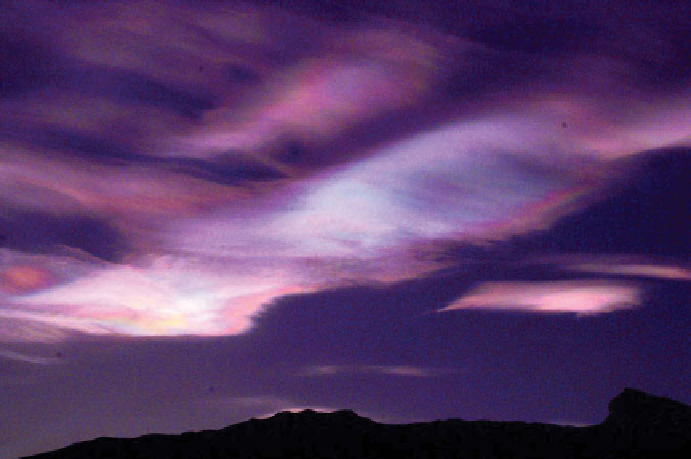Geoscience Reference
In-Depth Information
Figure 11.17.
Polar stratospheric clouds, photographed in the spring of 2000 in the Arctic. NASA.
Typical diameters of Type II PSCs are 20
m, varying
ClONO
2
(g)
+
HCl(a)
→
Cl
2
(g)
+
HNO
3
(a)
from 1 to 100
m. Typical number concentrations are
Chlorine
Adsorbed
Molecular
Adsorbed
nitrate
hydrochloric
chlorine
nitric
0.1 particles cm
−
3
.Assuch, Type II PCSs are larger
in size but fewer in number than are Type I PSCs. The
larger size of the Type II PSC suggests it falls from
the stratosphere faster than does a Type I PSC. Because
Type II PSCs are more difficult to form (because of
their lower temperature threshold), and because they
fall faster, the number concentration of Type II PSCs
is much less than is that of Type I PSCs. One study
estimated that about 90 percent of PSCs are Type I,
and 10 percent are Type II, when both can form (Turco
et al., 1989).
≤
(11.35)
acid
acid
N
2
O
5
(g)
+
H
2
O(s)
→
2HNO
3
(a)
(11.36)
Dinitrogen
Water-ice
Adsorbed
pentoxide
nitric
acid
N
2
O
5
(g)
+
HCl(a)
→
ClNO
2
(g)
+
HNO
3
(a)
Dinitrogen
Adsorbed
Chlorine
Adsorbed
pentoxide
hydrochloric
nitrite
nitric
(11.37)
acid
acid
HOCl(g)
+
HCl(a)
→
Cl
2
(g)
+
H
2
O(s)
(11.38)
Hypochlorous
Adsorbed
Molecular
Water-ice
acid
hydrochloric
chlorine
acid
11.8.2. Polar Stratospheric Cloud
Surface Reactions
Once PSC particles form in the dark polar winter strato-
sphere, when temperatures are extremely low, chemical
reactions take place on their surfaces. Such reactions
are called
heterogeneous reactions
and occur after at
least one gas has diffused to and adsorbed to a particle
surface.
Adsorption
is a process by which a gas collides
with and bonds to a surface. The primary heterogeneous
reactions that occur on Type I and II PSC surfaces are
In these reactions, (g) denotes a gas, H
2
O(s) denotes
awater-ice surface, HCl(a) denotes HCl adsorbed to
either a Type I or II PSC surface, and HNO
3
(a) denotes
HNO
3
adsorbed to a Type I or II PSC surface. Additional
reactions occur for bromine.
Laboratory studies show that HCl(g) readily diffuses
to and adsorbs to the surfaces of Type I and II PSCs.
When ClONO
2
(g), N
2
O
5
(g), or HOCl(g) impinges
upon the surface of a Type I or II PSC, it can react with
H
2
O(s) or HCl(a) already on the surface. The products
of these reactions are adsorbed species, some of which
stay adsorbed, whereas others desorb to the vapor phase.
Those that desorb to the vapor phase go on ultimately
to destroy ozone nearby.
ClONO
2
(g)
+
H
2
O(s)
→
HOCl(g)
+
HNO
3
(a)
Chlorine
Water-ice
Hypochlorous
Adsorbed
nitrate
acid
nitric
acid
(11.34)


Search WWH ::

Custom Search